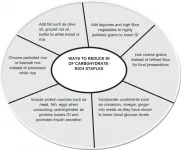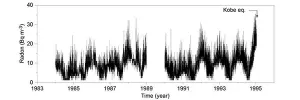Researchers discover how to control zinc in plants: Could help the world's malnourished
Over 2 billion people worldwide are malnourished due to zinc deficiency. Led by the University of Copenhagen, an international team of researchers has discovered how plants sense zinc and use this knowledge to enhance plant zinc uptake, leading to an incr
2021-03-04
(Press-News.org) Researchers discover how to control zinc content in plants: Could help the world's malnourished
Over 2 billion people worldwide are malnourished due to zinc deficiency. Led by the University of Copenhagen, an international team of researchers has discovered how plants sense zinc and use this knowledge to enhance plant zinc uptake, leading to an increase in seed zinc content by 50 percent. The new knowledge might one day be applied towards the cultivation of more nutritious crops.
A deficiency of zinc and other essential dietary nutrients is one of the greatest causes of malnutrition worldwide. More than two billion people are estimated to suffer from zinc deficiency, a problem that can lead to impaired immune systems, mental disorders and stunting. Among other things, malnutrition can be caused by infertile agricultural land, which affects the nutritional content of staple crops such as rice, wheat and maize.
But imagine that it was possible to flip a switch in crops, at the seed stage, that prompted them to turbocharge their intake of zinc, iron or other nutrients, and cause them to absorb more nutrients than they would otherwise. Researchers at the University of Copenhagen's Department of Plant and Environmental Sciences have done just that using the thale cress plant (Arabidopsis thaliana).
"For the first time ever, we have demonstrated that, by using a molecular 'switch' in the plant, we can cause the plant to absorb more zinc than it would otherwise, without apparent negative impact on the plant," states the study's lead author, Associate Professor Ana Assunção of the University of Copenhagen's Department of Plant and Environmental Sciences.
Plants absorbed 50 percent more zinc
Zinc benefits humans by helping to maintain a wide array of chemical processes and proteins running within our bodies. Should these processes cease to function properly, we become prone to illness. For plants, the absence of zinc primarily impacts growth, which is adversely affected in the absence of zinc.
Researchers have long attempted to understand how plants increase and decrease their zinc uptake. Ana Assunção and her colleagues have become the first to identify two specific proteins from thale cress that act as zinc sensors and determine the plant's ability to absorb and transport zinc throughout plant tissue.
By changing the properties of these sensors, or molecular "switch", that control a tightly connected network of zinc transporters, the researchers succeeded in getting them to absorb more zinc.
"Simply put, by making a small change in the sensor, we've led the plant to believe that it was in a permanent state of zinc deficiency. This kept the plant's zinc uptake machinery swiched-on and resulted in an increase of zinc content in the seeds by as much as 50 percent compared to a normal plant," explains Grmay Lilay, the study's first author, Postdoc at Assunção's Lab .
Up next: rice and beans
The researchers have demonstrated that it is possible to increase zinc-absorption in their experimental plant, but the next step is to reproduce the results in real crops. And the researchers are already well on the way to doing so.
"We're currently working to recreate our results in bean, rice and also tomato plants. Should we succeed, we'll realize some interesting opportunities to develop more nutritious and biofortified crops. Biofortification is a sustainable solution to improve micronutrient content in human diet," says Associate Professor Assuncao.
In the long term, the researchers' results could be applied by using CRISPR gene editing or by selecting naturally occurring crop varieties with a particularly good ability to absorb nutrients like zinc.
"The availability of enormous genomic resources will assist our efforts in finding crop varieties that are likely to display higher zinc accumulation, " concludes Grmay Lilay.
INFORMATION:
The result was achieved in collaboration with Wageningen University and the University of Porto and has just been published in the renowned journal Nature Plants.
Fact box:
* Zinc is a key structural and catalytic component of a large number of proteins. For all proteins to function properly, an optimal zinc supply needs to be maintained, avoiding deficiency or toxicity.
* In humans, the risk of zinc deficiency alone can lead to different degrees of growth retardation, immune dysfunction, and cognitive impairment.
Contact:
Ana Assuncao
Associate Professor
Department of Plant and Environmental Sciences
University of Copenhagen
Mobile: +45 21631243
Mail: agla@plen.ku.dk
Michael Skov Jensen
Journalist
The Faculty of Science
University of Copenhagen
Mobile:+ 45 93 56 58 97
msj@science.ku.dk
ELSE PRESS RELEASES FROM THIS DATE:
2021-03-04
Glycine can stimulate or inhibit neurons in the brain, thereby controlling complex functions. Unraveling the three-dimensional structure of the glycine transporter, researchers have now come a big step closer to understanding the regulation of glycine in the brain. These results, which have been published in Nature, open up opportunities to find effective drugs that inhibit GlyT1 function, with major implications for the treatment of schizophrenia and other mental disorders.
Glycine is the smallest amino acid and a building block of proteins, and also a critical neurotransmitter that can both stimulate or inhibit ...
2021-03-04
The oceans are becoming more acidic because of the rapid release of carbon dioxide (CO2) caused by anthropogenic (human) activities, such as burning of fossil fuels. So far, the oceans have taken up around 30% of all anthropogenic CO2 released to the atmosphere. The continuous increase of CO2 has a substantial effect on ocean chemistry because CO2 reacts with water and carbonate molecules. This process, called 'ocean acidification', lowers pH, and calcium carbonate becomes less available. This is a problem for calcifying organisms, such as corals and molluscs, that use calcium carbonate as the main building blocks of their exoskeleton.
In particular, organisms that build their shells from a type of calcium carbonate known as 'aragonite' are in trouble because aragonite is ...
2021-03-04
?Micro-Doppler radars could soon be used in clinical settings to predict injury risk and track recovery progress, according to Penn State researchers.?
Being able to view subtle differences in human movement?would allow health care workers to more accurately identify individuals who may be at risk for injury and to track progress precisely while individuals are recovering from an injury. In an effort to find an accurate, reliable and cost-effective way to measure these subtleties ?in human movement, College of Engineering and College of Medicine researchers teamed up to develop a radar in front ...
2021-03-04
Professor Christiani Jeyakumar Henry, Senior Advisor of Singapore Institute of Food and Biotechnology Innovation (SIFBI), Agency for Science, Technology and Research (A*STAR) and his team have developed a Glycaemic Index (GI) glossary of non-Western foods. The research paper was published in Nutrition & Diabetes on 6 Jan 2021: https://doi.org/10.1038/s41387-020-00145-w.
Observational studies have shown that the consumption of low glycaemic index (GI) foods is associated with a lower risk of type 2 diabetes mellitus (T2DM), significantly less insulin resistance and a lower prevalence of the metabolic syndrome. However, most published GI values focus on Western foods with minimal inclusion of other foods from non-Western countries, hence their application ...
2021-03-04
Tohoku University researchers have unearthed further details about radon concentration in the atmosphere before and after earthquakes, moving us closer to being able to anticipate when large earthquakes may hit.
The results of their research were published in the journal Science Reports on February 18, 2021.
Radon is a radioactive noble gas derived from radioactive decays of radium-226 in the ground. Radon bubbles up to the surface and is expelled into the atmosphere.
It has long been known that elevated levels of radon underneath the ground can be detected before and after earthquakes. But the relationship between the mechanisms that cause abnormal changes in radon concentration and the occurrence of earthquakes requires greater ...
2021-03-04
Interspecies interactions are the foundation of ecosystems, from soil to ocean to human gut. Among the many different types of interactions, syntrophy is a particularly important and mutually beneficial interspecies interaction where one partner provides a chemical or nutrient that is consumed by the other in exchange for a reward.
Syntrophy plays an essential role in global carbon cycles by mediating the conversion of organic matter to methane, which is about 30 times more potent than carbon dioxide as a greenhouse gas and is a source of sustainable energy. And in the human gut, trillions of microbial cells also interact ...
2021-03-04
Intelligent holographic nanostructures on CMOS sensors for energy-efficient AI security schemes
Today, machine learning permeates our everyday life, with millions of users every day unlocking their phones through facial recognition or passing through AI-enabled automated security checks at airports and train stations. These tasks are possible thanks to sensors that collect optical information to feed it to a neural network in a computer. Imagine to empower the sensors in the devices you use every day to perform artificial intelligence functions without a computer - as simply as putting glasses on them.
The integrated holographic perceptrons developed by a research team at University of Shanghai for Science and Technology led ...
2021-03-04
Nairobi/Paris, 4 March 2021 - An estimated 931 million tonnes of food, or 17% of total food available to consumers in 2019, went into the waste bins of households, retailers, restaurants and other food services, according to new UN research conducted to support global efforts to halve food waste by 2030.
The weight roughly equals that of 23 million fully-loaded 40-tonne trucks -- enough bumper-to-bumper to circle the Earth 7 times.
The Food Waste Index Report 2021, from the United Nations Environment Programme (UNEP) and partner organization WRAP, looks at food waste that occurs in retail outlets, restaurants and homes - ...
2021-03-04
People with higher incomes tend to feel prouder, more confident and less afraid than people with lower incomes, but not necessarily more compassionate or loving, according to research published by the American Psychological Association.
In a study of data from 162 countries, researchers found consistent evidence that higher income predicts whether people feel more positive "self-regard emotions," including confidence, pride and determination. Lower income had the opposite effect, and predicted negative self-regard emotions, such as sadness, fear and shame. The research was published online in the journal Emotion. ...
2021-03-04
A group of researchers, spanning six universities and three continents, are sounding the alarm on a topic not often discussed in the context of conservation--misinformation.
In a recent study published in FACETS, the team, including Dr. Adam Ford, Canada Research Chair in Wildlife Restoration Ecology, and Dr. Clayton Lamb, Liber Ero Fellow, both based in the Irving K. Barber Faculty of Science, explain how the actions of some scientists, advocacy groups and the public are eroding efforts to conserve biodiversity.
"Outcomes, not intentions, should be the basis for how we view success in conservation," says Dr. Ford.
"Misinformation related to vaccines, climate change, and links between smoking ...
LAST 30 PRESS RELEASES:
[Press-News.org] Researchers discover how to control zinc in plants: Could help the world's malnourished
Over 2 billion people worldwide are malnourished due to zinc deficiency. Led by the University of Copenhagen, an international team of researchers has discovered how plants sense zinc and use this knowledge to enhance plant zinc uptake, leading to an incr




